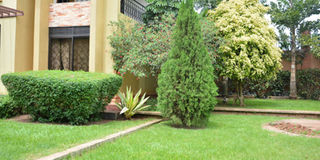Landscaping solutions to stop flooding in compounds

Adding mulch to a compound especially at the bottom of trees and other plants will trap rain water and prevent puddling.
What you need to know:
- Now that the rainy season is here, flooding and puddling of compounds are to be expected. If you beat the rain to this by installing preventive measures before, well and good. However, if you have been caught off guard, it’s never too late to rectify the problem. A few simple landscaping tricks are all you need.
Flooding and puddling are common in areas such as Kasubi, Katanga, Kabuusu, Namungoona and Kinawataka . In cases of heavy downpour, even homes in areas considered to be safe from flooding with be caught up in this wet mess.
Landscaping solutions
Create swales away from your house. A swale, according to Ms Ethel Chrissy Namono, a landscaper with Iconic Hedges, is a low tract of land that is created to send rain water away from a home.
“Creating swales can be the best solution to flooding and puddling in a home. If water often gathers around your house’s base, create a swale,” Ms Namono says.
She points out that one can only create a swale by first creating a berm, which she describes as a raised area of land at the top of a swale.
“A berm helps support a swale when it comes to channelling water out of a compound. It can be created by either bringing in new soil, or using extra soil to create a level and raised border around your home. The water will then run down the berm into the gravel-filled swale when it rains,” Ms Namono says.
She notes that to make this more efficient, it is usually advisable to plant grass and plants both on the berm and swale. This, she says, helps ensure that the water is absorbed by the plants when it rains, preventing the soil from eroding.
Cost of creating a swale
Ms Namono says the total cost of coming up with this in a landscape depends on the size of the area.
“The approximate cost would be roughly between Shs300,000 to Shs600,000 or even more depending on how large one’s landscape may be,” she says.
Make a rain garden
Having a rain garden is another way of preventing puddling and flooding. A rain garden, Ms Namono explains, is a garden of native shrubs, perennials, and flowers planted in a small depression. She says the garden is designed to temporarily hold and soak in rain water runoff that flows from roofs, driveways, patios or lawns.
“Water will generally gather anywhere depressions are. Instead of having these areas turn into muddy pits and depressions filled with water, it is advisable for one to instead turn them into beautiful rain gardens,” says Ms Namono. The required depth for a rain garden according to her is usually between 18 to 36 inches deep, with a 6 feet ponding area. She says that the total cost of coming up with a rain garden may sum up to roughly Shs300,000.
Incorporate mulch
Mulch, according to Mr Ben Mitala, a landscaper, is one of the best ways of preventing flooding and puddling in a landscape since it does a good job of absorbing water.
“One can create a barrier around their home that is filled with plants and mulch them. A combination of mulch and plants can absorb a good amount of rain water,” he says.
He adds that for mulch to be effective, it would have to be at least two to four inches deep. This, Mitala says, creates enough mulch for water absorption.
“In doing this, however,” he cautions that, “one needs to leave some space between the plants’ roots and the mulch. Doing this enables the plants to have an uninterrupted access to water since in some cases water mulch may end up stopping the plants from accessing enough water required.”
Man-made rivers
One of the other ways of preventing puddling and flooding can be through creating rivers within a landscape.
This, Mr Mitala says, can help direct rain water out of the landscape. But for it to work effectively, he says, one would have to place rocks within the river.
Mr Mitala however says that can only be opted for if one has ample compound space.
He says this adds a more natural and breath-taking allure to the compound.
Man-made river
Creating a small man-made river can be expensive in the sense that one would have to dig up the land and ensure that water flows.
The total cost may even go up to Shs5m depending on how big the land is.




